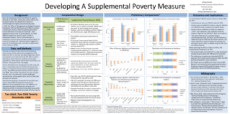
An official website of the United States government
Here’s how you know
Official websites use .gov
A .gov website belongs to an official government organization in the United States.
Secure .gov websites use HTTPS
A lock (
) or https:// means you’ve safely connected to the .gov website. Share sensitive information only on official, secure websites.
-
//
- Census.gov /
- Library /
- Census Working Papers /
- Developing A Supplemental Poverty Measure
Developing A Supplemental Poverty Measure
Developing A Supplemental Poverty Measure
Abstract
Since the introduction of the first official U.S. poverty estimates in the 1960’s, researchers, policy makers, and the general public have debated the measure’s methodological strengths and policymaking value. In 2009, the Office of Management and Budget formed an Interagency Technical Working Group (ITWG) to consider a new poverty measure that incorporated alternative income definitions and resource thresholds. Their suggestions drew on the recommendations of a 1995 National Academy of Sciences report as well as subsequent research. The U.S. Census Bureau, in cooperation with the Bureau of Labor Statistics (BLS), has since been charged with implementing the suggestions made by the Working Group to develop a Supplemental Poverty Measure (SPM).
In comparing the “official” poverty measure and the SPM, we find that overall poverty rates are higher under the SPM, poverty rates are lower for children using the SPM but are higher for both nonelderly and elderly adults. Poverty rates are also higher for White non-Hispanics, “Other” race categories, and individuals reporting Hispanic Origin but are lower for Black non-Hispanics. The share of the persons in poverty living in nonmetropolitan areas, the South, and the Midwest is smaller using the SPM than the official measure. The share of persons in poverty living in the suburbs, the Northeast, and the West is larger using the SPM than the official measure. When observing the effects of taxes, transfers, and nondiscretionary expenses, we find that the Earned Income Tax Credit (EITC) is a key mechanism moving resources above the SPM poverty thresholds. The subtraction of medical out-of-pocket (MOOP) expenses from income pushes resources below the SPM poverty thresholds for many individuals. The largest resource additions for lower income SPM Resource Units were from the Supplemental Nutrition Assistance Program (SNAP) while the largest resource subtractions were from MOOP expenditures.
Share
Related Information
WORKING PAPER
Supplemental Poverty Measure Working PapersSome content on this site is available in several different electronic formats. Some of the files may require a plug-in or additional software to view.
 Yes
Yes
 No
NoComments or suggestions?


Top

